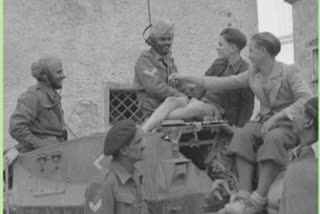New Delhi:Nearly 77 years after thousands of Indian soldiers made the supreme sacrifice while fighting for the liberation of Italy during World War II, an Indian Army Memorial will be inaugurated in Monte Cassino in the province of Frosinone, southeast of Rome by the Indian Army chief General M.M. Naravane this coming week. While the focus of Naravane's two-day visit to Italy on July 7-8 will be on enhancing the defence cooperation between both countries, there will also be a heady mix of history, remembering and honouring the contribution of Indian soldiers, whose heroic tales of sacrifice and bravery are still much talked about deep inside the Italian communes liberated by them between 1943 to 1945.
As many as 5,782 Indian soldiers had laid down their lives during the campaign - it is said that they lie in 40 cemeteries all over the country, the major ones being at Cassino, Arezzo, Florence, Forl, Sangro River and Rimini - with six of them receiving the Victoria Crosses out of the 20 that were awarded for the freedom of Italy. "Every man who served in the Armed Forces of India was a volunteer, and each did so as a matter of honour. Those who died had accepted duty and were faithful unto death. Of no man, can more be said, than this," mentions the UK-based Commonwealth War Grave Commission Booklet on India's War Dead.
Read:|Army Chief leaves for UK and Italy
India's contribution was also the third-largest during the Italian campaign, after the British and the US. The Indian Defence Ministry lists that there were around 50,000 Indian troops, mostly between the ages of 19 to 22, who fought for Italy's liberation after the first party landed at Taranto in the south of Naples on September 19, 1943. From then until 29 April 1945, they were engaged in a heroic mission which was visible in the battle to take Monte Cassino, the battle for Sangro river and Liri Valley, the advance along the east coast to Bologna, the crossing of Senio river and the battle of Gothic lines.
Monte Cassino - where young Indian soldiers who fought with bravery far away from home. Indian soldiers' massive footprint on the Italian soil during the Second World War has been extensively covered in a book titled 'A tribute to the young Indian soldiers who fought with bravery far away from home' published by the Indian embassy in Rome, about 14 years ago. It details that by the end of October 1943, the Allies were facing the German winter defensive position, the Gustav Line. Initial attempts to breach the western end of the line were unsuccessful. Operations in January 1944 landed the Allied troops behind the German lines at Anzio, but the German defences were well organised, and a breakthrough was not actually achieved until 18 May, when Cassino was finally taken. The 4th Indian Division took part in the Battles of Cassino and suffered over 4000 casualties.
Read:|Eyes on niche tech, Army chief labels drones 'new challenge'
